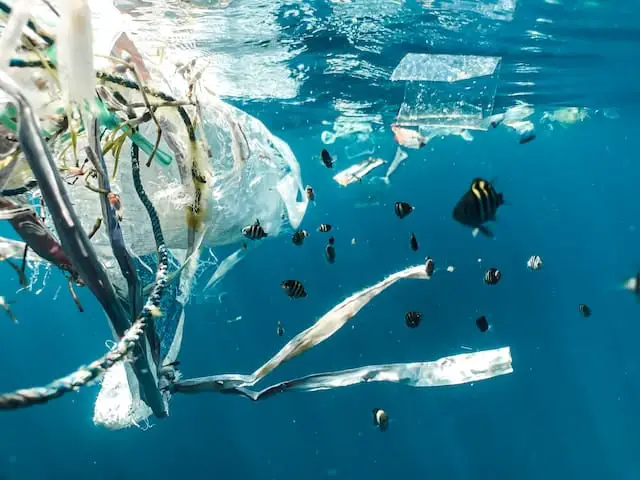
If you are reading this blog, I am sure you have heard of forever chemicals, also known as PFAS (poly-fluoroalkyl substances). The first thing you’ll hear about PFAS is that quite frankly, they are around forever, this also applies in particular to water sources, once they are in the water source. they don’t break down naturally. Furthermore, it is quite well-known that PFAS are not good for your health. In order to understand this topic further I got researching and came up with this complete guide on the topic which among other things summarises, what PFAS are, why they’re bad and how you can get rid of them!
Forever chemicals, aka PFAS are a group of chemicals and plastics that don’t naturally break down in water and are linked to many health issues. PFAS are Utilized for their heat, water and oil resistance which also makes them difficult to remove, reverse-osmosis is the best method to reduce PFAS in water.
What Are PFAS?
Forever chemicals (PFAS) are a group of over 4,700 man-made chemicals that are used in a wide range of products, including non-stick cookware, waterproof clothing, and firefighting foam. These chemicals are highly resistant to heat, water, and oil, making them ideal for use in these products. Forever chemicals are also used in food packaging, carpets, and cleaning products.
Examples of Forever Chemicals in Household Products:
- Non-stick cookware: PFOA (perfluorooctanoic acid) and PFOS (perfluorooctane sulfonate) are commonly used in non-stick cookware, such as Teflon pans. These chemicals can leach into food when the cookware is heated and have been linked to cancer, thyroid disease, and developmental disorders.
- Stain-resistant carpeting: PFAS are often used in stain-resistant carpeting to prevent spills from penetrating the fibres. However, these chemicals can release toxic gases when heated and have been linked to cancer and developmental disorders.
- Personal care products: PFAS are sometimes added to personal care products, such as shampoo and toothpaste, to create a lather. These chemicals can be absorbed through the skin and have been linked to hormone disruption and other health problems.
Examples of Forever Chemicals in Commercial Products:
- Firefighting foam: PFAS are commonly used in firefighting foam because of their ability to extinguish fires quickly. However, these chemicals can contaminate soil and groundwater and have been linked to cancer and other health problems.
- Industrial manufacturing: PFAS are used in a wide range of industrial processes, including the production of electronics, textiles, and plastics. These chemicals can contaminate soil and groundwater and have been linked to cancer, thyroid disease, and developmental disorders.

How Do They Get Into Water?
PFAS can enter the water supply from a variety of sources, including industrial sites, landfills, and wastewater treatment plants. PFAS can also enter the water supply from products that contain them, such as non-stick cookware and waterproof clothing.
Some specific ways that forever chemicals can get into water supplies include:
- Industrial and commercial releases: Forever chemicals are commonly used in industrial and commercial processes, such as the production of electronics, textiles, and plastics. These chemicals can be released into the environment through air emissions, wastewater discharges, and landfills.
- Firefighting foam: PFAS are often used in firefighting foam because of their ability to extinguish fires quickly. However, when used at training facilities or in response to fires, the foam can enter the environment and contaminate groundwater and surface water.
- Landfills and waste sites: Forever chemicals can leach out of landfills and waste sites and enter nearby groundwater and surface water.
- Consumer products: Forever chemicals are used in a wide range of consumer products, such as non-stick cookware, waterproof clothing, and personal care products. These chemicals can leach out of these products and enter water supplies.
Why Are PFAS Bad For You?
PFAS have been linked to a range of health problems, including cancer, thyroid disease, and developmental disorders. These chemicals are known as “forever chemicals” because they do not break down easily in the environment, which means they can accumulate in the body over time. Even low levels of exposure to PFAS can be harmful, which is why it is important to remove them from drinking water.
Research has shown that PFAS exposure can lead to a range of adverse health effects, including cancer, immune system dysfunction, and reproductive issues. Exposure to PFAS has been linked to thyroid disease, liver damage, and developmental delays in infants and children.
One of the most concerning health effects of PFAS exposure is their potential to cause cancer. Studies have shown that certain types of PFAS, such as perfluorooctanoic acid (PFOA) and perfluorooctanesulfonic acid (PFOS), are associated with an increased risk of kidney and testicular cancer. Additionally, exposure to PFAS has been linked to bladder, prostate, and breast cancer.
Another way in which PFAS can harm human health is by disrupting the immune system. Exposure to PFAS has been shown to reduce the effectiveness of vaccines and increase the risk of infections. In addition, PFAS can interfere with the body’s natural response to infections, making it more difficult to fight off diseases.
PFAS exposure has also been linked to reproductive issues, including reduced fertility and delayed onset of puberty. In women, exposure to PFAS has been associated with decreased levels of estrogen and progesterone, which can affect fertility and menstrual cycles. In men, PFAS exposure has been shown to decrease sperm quality and quantity.
Furthermore, PFAS exposure can exacerbate existing health conditions. For example, exposure to PFAS can worsen symptoms of asthma and allergies, as well as increase the risk of developing autoimmune diseases such as rheumatoid arthritis and lupus.
How To Remove PFAS From Water?

Removing PFAS from water is a complex process that requires specialized equipment for methods such as fractional distillation, however, there are some existing solutions that can help reduce PFA levels in drinking water such as activated carbon filters and reverse osmosis
Activated carbon filters:
Activated carbon filters work by adsorbing the PFAS onto the surface of the carbon. The carbon has a large surface area and a high number of microscopic pores, which allows it to effectively capture and retain the PFAS molecules as water passes through the filter.
Studies have shown that activated carbon filters can remove up to 90% of PFAS from drinking water, depending on the specific type of PFAS and the quality of the filter. In some cases, certain types of PFAS may be more difficult to remove than others, which can affect the overall effectiveness of the filter.
If you are interested in reading more about activated carbon filters, I suggest you read some of the following articles relevant to the topic:
How Long Does It Take For Charcoal To Filter Water?
Does Barbecue Charcoal Filter Water? What’s The Difference?
How To Activate Charcoal To Filter Water: 10 Simple Steps
Reverse osmosis (RO) filters:
Reverse osmosis systems use a semi-permeable membrane to remove contaminants from water. Water is forced through the membrane under high pressure, which allows water molecules to pass through while blocking larger contaminants, including PFAS.
Reverse osmosis systems are highly effective at removing PFAS from water, with some studies reporting removal rates of up to 99%. However, it is important to note that the effectiveness of the system may depend on factors such as the specific type of PFAS, the concentration of contaminants in the water, and the quality of the reverse osmosis membrane.
If you are interested in reading an in-depth article on the various types of reverse osmosis filters for the home, including the pre and post-filtration setups, I wrote a comprehensive article on the topic that I encourage you to read: How Many Stages Are There In Reverse Osmosis? It Depends!
Why Some Common Filters Cannot Remove PFAS?

It is important to note that not all water filters are designed to remove PFAS. Many common water filters, such as those found in pitchers and faucet-mount systems, are primarily designed to remove chlorine taste and odour, sediment, bacteria and other basic contaminants.
Distillation Filters:
Although fractional distillation is effective at removing PFAS, regular distillation is not necessarily effective at removing PFAS. According to the Minnesota Department of Health, “distillation may be ineffective at removing some PFAS from drinking water because some PFAS have boiling points higher/lower than water and may carry over with the steam”. Fractional distillation targets the differences in boiling points and ensures only water is captured and condensed back to water, regular distillation will capture everything that boils up to a certain temperature
Ion Exchange Filters:
Ion exchange filters use a resin to remove contaminants from water by exchanging ions with the water. While these filters may be effective at removing some types of contaminants, including lead and copper, they are generally not effective at removing PFAS. According to the Environmental Working Group, “ion exchange resin filters… may not effectively reduce levels of some PFAS in tap water.”
UV Filters:
UV filters use ultraviolet light to kill bacteria and other microorganisms in water. While UV filters can be effective at disinfecting water, they are ineffective at removing PFAS.
How To Test For PFAS In Water?
There are a few different ways to test for PFAS in water. The most accurate method is to send a water sample to a certified laboratory for testing. Home test kits are also available, but these may not be as accurate as laboratory testing.
One common laboratory method for PFAS testing is called liquid chromatography-tandem mass spectrometry (LC-MS/MS). This method involves extracting PFAS from a water sample and then separating and analyzing them using specialized equipment. LC-MS/MS can detect a wide range of PFAS and is considered the gold standard for PFAS testing.
Another laboratory method for PFAS testing is called enzyme-linked immunosorbent assay (ELISA). This method uses antibodies to detect specific PFAS in a water sample. ELISA is less expensive than LC-MS/MS but may not be as accurate and reliable, as it can only detect a limited number of PFAS.
Home test kits for PFAS are also available and can be purchased online or at some hardware stores. These test kits typically involve collecting a water sample and then sending it to a laboratory for analysis. The accuracy and reliability of home test kits can vary, so it is important to choose a reputable brand and follow the instructions carefully.
One example of a reputable brand of home test kits for PFAS is the PurTest Home PFAS Test Kit. This kit uses the same LC-MS/MS method used by many laboratories, but in a simplified form that can be done at home. The kit includes everything needed to collect and ship a water sample, and results are typically available within 10-14 days.
Another example of a home test kit for PFAS is the Watersafe Well Water Test Kit. This kit tests for several different contaminants, including PFAS, and can provide results within 10 minutes. The kit includes test strips that change colour in the presence of certain contaminants, making it easy to interpret the results.
References:
Environmental Protection Agency. (2021). PFAS Treatment Options. Retrieved from https://www.epa.gov/pfas/pfas-treatment-options
Centers for Disease Control and Prevention. (2021). PFAS and Your Health. Retrieved from https://www.cdc.gov/pfas/health-effects.html
Consumer Reports. (2020). How to Remove PFAS From Drinking Water. Retrieved from https://www.consumerreports.org
United States Environmental Protection Agency. (2021). Per- and Polyfluoroalkyl Substances (PFAS). https://www.epa.gov/pfas/basic-information-pfas
National Institute of Environmental Health Sciences. (2021). Per- and Polyfluoroalkyl Substances (PFAS). https://www.niehs.nih.gov/health/topics/agents/pfas/index.cfm
Minnesota Department of Health. (2019). PFAS Treatment Options for Drinking Water. https://www.health.state.mn.us/communities/environment/water/pfas/treatment.html
US Environmental Protection Agency. (2021). Drinking Water Treatability Database – PFAS. https://iaspub.epa.gov/tdb/pages/treatment/treatmentOverview.do?treatmentProcessId=1474
U.S. Environmental Protection Agency. (2021). EPA Method 537.1: Determination of Selected Per- and Polyfluoroalkyl Substances in Drinking Water by Solid Phase Extraction and Liquid Chromatography/Tandem Mass Spectrometry (LC/MS/MS). https://www.epa.gov/sites/default/files/2021-05/documents/method_537-1_2021-05-26_508_0.pdf
PurTest. (n.d.). Home PFAS Test Kit. https://www.purtest.com/home-pfas-test-kit/


